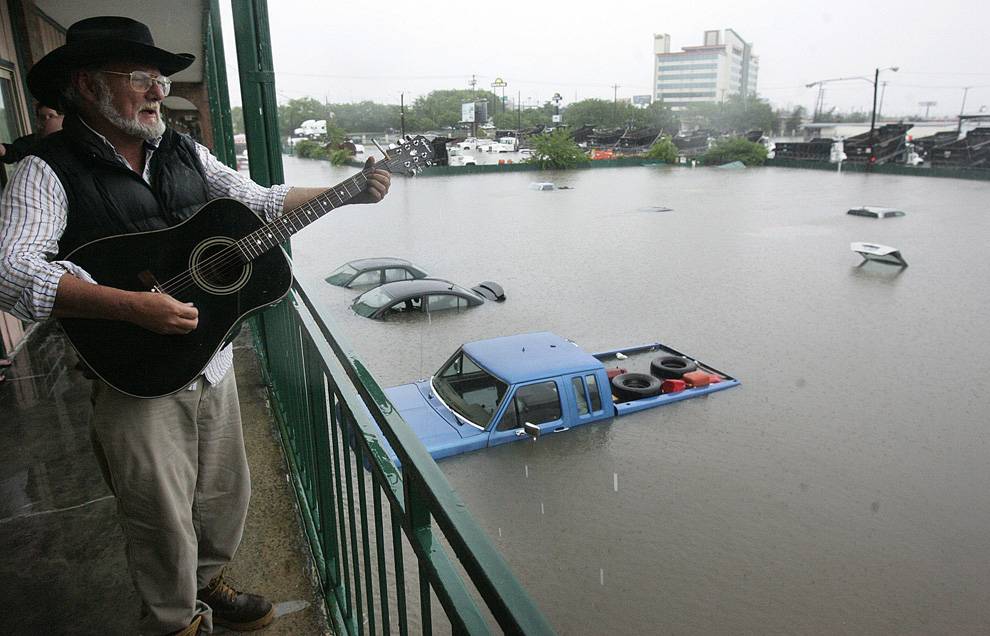
The floods that hit the southeast two weekends ago are probably old news to most of you by now. While mainstream media was slow to pick up on the devastation (what with a failed car bombing attempt and a massive oil spill, the press understandably had other things on their minds), by now the Flood of 2010 has made headline news, thanks in part to several high-profile, generous donations from Taylor Swift, Ke$ha, the CMA Festival, and now, Jerry Seinfeld.
For me, though, Sunday and the days after were terrifying, agonizing. I watched my home, the city I’ve spent most of my life in, go underwater. I desperately called friends and family, getting bad news and relatively better news. A basement flooded, a house spared. An entire art gallery submerged under five feet of water, the art and space destroyed. A family stranded on their second floor, waiting for the waters to recede and the city to emerge. I sat here in Urbana, feeling helpless.
Above photo from the Boston Globe
For those of you that are still relatively removed from the news, let me try to give you an idea of what Nashville, much of Tennessee, and other affected areas in the southeast are going through (and point you toward those who can do a better job).
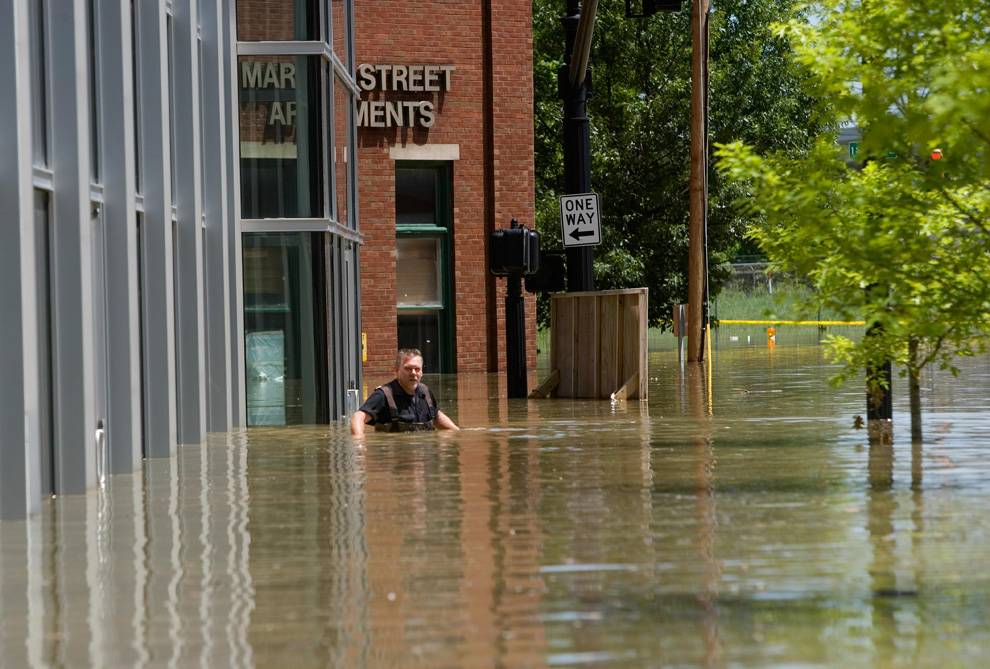
(Photo from the Boston Globe)
May 1st and 2nd, Tennessee experienced record-breaking rainfall — 13.53 inches in two days, about a third of what the state gets on a yearly basis. The rainfall caused the Cumberland river to crest at 51.9 feet, 12 feet above flood level. Interstates and major roadways flooded. One of two Metro water treatment facilities flooded, threatening water supplies throughout Davidson County and prompting the city to call for a mandatory water conservation order, which still remains in effect. The second facility was spared by a mere seven inches thanks to the overnight sandbagging efforts of Davidson County inmates, who volunteered over 36-consecutive hours to fight back the floodwaters. The only wastewater treatment plant in Montgomery County flooded, leaving the County no option but to allow untreated sewage to flow directly into the Cumberland River. Two major hospitals flooded. Fifty-six schools were damaged in Nashville alone. At last count, the death toll was 31, with 10 of those in Nashville.
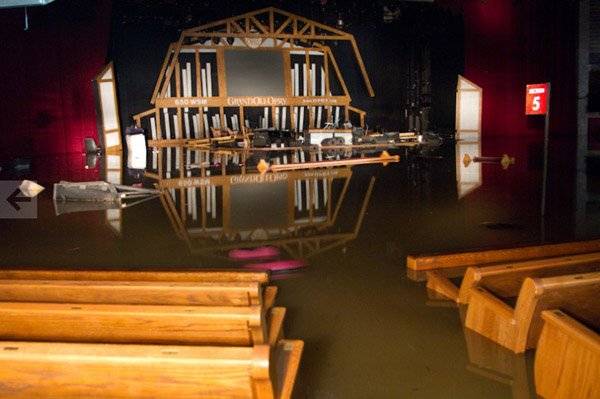 The floods also damaged many of the most treasured buildings in Nashville. The stage at the Grand Ole Opry (left, photo courtesy of the Tennessean) was completely submerged. The Opryland Hotel will be closed for several months at least, and the Opry Mills Mall had ten feet of flood water. Schermerhorn Symphony Center’s basement completely flooded, severely damaging the 2.5 million-dollar organ the city acquired in 2007. LP Field, home of the Tennessee Titans, became a gigantic swimming pool. The Bridgestone Arena, home to the Nashville Predators, received significant damage. The Farmer’s Market flooded. The Country Music Hall of Fame had 5 ½ feet of water in its mechanical rooms.
The floods also damaged many of the most treasured buildings in Nashville. The stage at the Grand Ole Opry (left, photo courtesy of the Tennessean) was completely submerged. The Opryland Hotel will be closed for several months at least, and the Opry Mills Mall had ten feet of flood water. Schermerhorn Symphony Center’s basement completely flooded, severely damaging the 2.5 million-dollar organ the city acquired in 2007. LP Field, home of the Tennessee Titans, became a gigantic swimming pool. The Bridgestone Arena, home to the Nashville Predators, received significant damage. The Farmer’s Market flooded. The Country Music Hall of Fame had 5 ½ feet of water in its mechanical rooms.
But it wasn’t just Nashville. Fifty-two of Tennesee’s 95 counties were affected, as well as parts of Kentucky. Entire farms were submerged, destroying crops, livestock, equipment, seed, fertilizer, and much more. Some of the worst damage was miles away from Nashville, not on the banks of the Cumberland, but surrounding some of its tributaries, in areas that have never experienced dangerous flooding and were ill-prepared to withstand the effects.
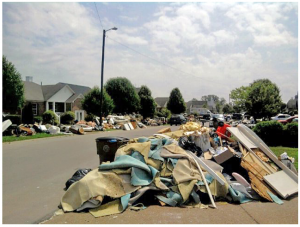 And it wasn’t just the city. What’s more devastating and less publicized than the landmarks that went under is the thousands of families whose lives have been so brutally disrupted. Anything absorbent that was touched by the floodwater must be discarded. Couches, beds, drywall, carpet, and insulation all sit on curbs alongside destroyed clothes, appliances, sheets, family heirlooms, all waiting to be picked up and dumped — much of which will make its way to one of the three temporary landfills set up by the state, including Percy Warner Park. (Photo from WPLN)
And it wasn’t just the city. What’s more devastating and less publicized than the landmarks that went under is the thousands of families whose lives have been so brutally disrupted. Anything absorbent that was touched by the floodwater must be discarded. Couches, beds, drywall, carpet, and insulation all sit on curbs alongside destroyed clothes, appliances, sheets, family heirlooms, all waiting to be picked up and dumped — much of which will make its way to one of the three temporary landfills set up by the state, including Percy Warner Park. (Photo from WPLN)
42 counties were officially declared disaster relief areas by the federal government, and 10 more have requested assistance. Estimated damages are at $1.56 billion for private property alone, and much of that will be beyond the scope of FEMA’s aid. In particular, no aid will be offered to landlords or renters, and aid to homeowners will be limited.
But it’s a lot easier to grasp the scope of the damage through pictures. Take a look at some of the many sites that have pictures of the extent of the damage throughout the state:
So why write this now? Why try to fill you in a week after the waters stopped rising?
Because the people and cities affected by this disaster are going to need help for a long time to come. As the media begins to look elsewhere and people’s minds move on, I urge you not to forget about the flood and the people that are still coping with its effects, and will be for years to come. There are plenty of ways that you can help, and, being out of state, most of those ways involve money. For those of you wanting to donate directly to flood relief, you can do so through:
The Community Foundation of Middle Tennessee
Second Harvest Food Bank of Middle Tennessee
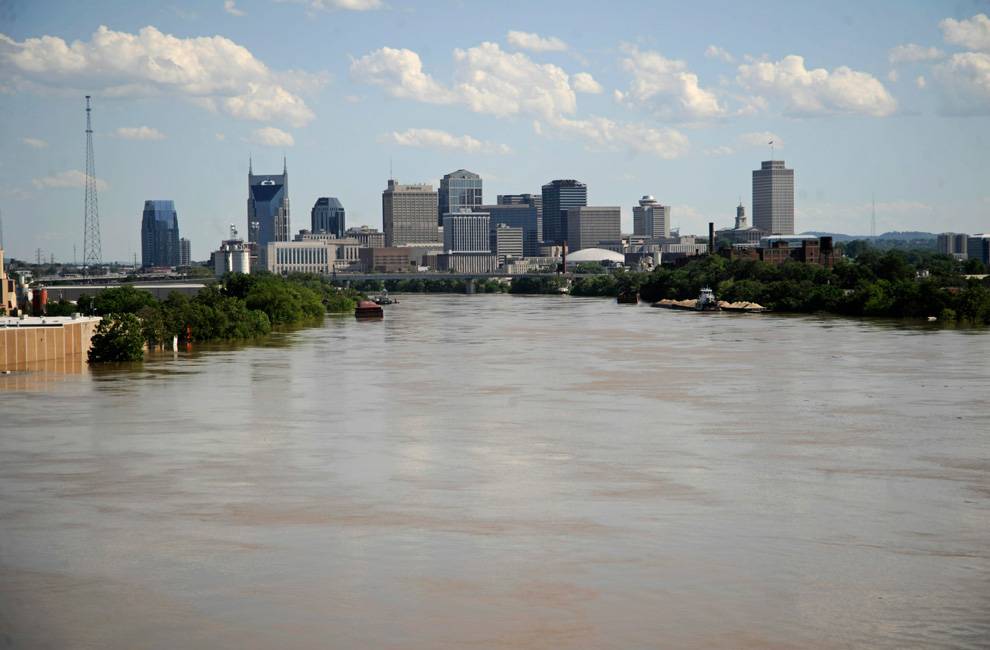
(Photo from the Boston Globe)
If you’ve got a little bit of Nashville in you too, here are a bunch of prints, shirts, and stickers you can buy to support flood relief and show your Tennessee love at the same time:
Thanks to some generous sponsors, all $20 (or $25) from these “We Are Nashville” shirts goes directly to flood relief.
These Nashville prints are $20, $15 of which is donated to United Way of Nashville (the other $5 covers shipping and printing).
These little, lovely stickers for only $4 donate to United Way as well.
Here you can get shirts and onesies, (all $20), with proceeds going to Cross Point Church, Grace Church of Nashville, United Way of Williamson County, and MusiCares, all for flood relief.
Tons of prints from various sites are cataloged here, from $10-20.
And if you can’t do any of that, there’s one more thing that you can do which would really, really help us out. Come visit. Not quite yet (we need a little bit of time), but soon — late summer, early fall, take a weekend and make the six-hour drive to one of the best little cities in the US. Walk through downtown, go to the Opry, the Bluebird Café, The Country Music Hall of Fame, and all the little bars, restaurants, music venues, and shops that make Nashville so wonderful. You’ll meet some of the friendliest people in the US, and get to see firsthand how resiliant the people of Nashville are. Hell, I’ll even show you around. (I truly will. Leave a comment, let’s talk.)
More links for those of you wanting to read more:
This exceptional piece about what the media missed about the flood from the Huffington Post.
“We Are Nashville“, a post by local hockey blogger Patten Fuqua which…
A look at why Nashville flooded from The City Paper.
“They Are Nashville”, from the Huffington Post.
The blog that’s been doing the best job of keeping us all up to date, Nashvillest.
Some personal accounts by bloggers who are more articulate than me:








